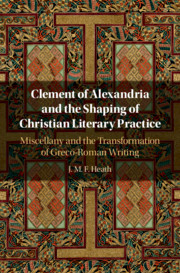 Clement of Alexandria and the Shaping of Christian Literary Practice
Clement of Alexandria and the Shaping of Christian Literary Practice Published online by Cambridge University Press: 16 December 2020
Classical miscellanists invented the trope of listing in a preface other people's miscellany titles, which they were not choosing for their own work. By giving this impressionistic snapshot of a book culture, they could position their own work in relation to Greek and Roman literary heritage. Clement adapted this trope to name Hellenised points of entry into the Christian imaginary of his literary project. In the preface to Str. VI, he listed Meadows, Helicons, Honeycombs, and Peploi as titles of other people's works. These name significant domains in Clement's own imagery; if sophisticated readers trace his networks of imagery, they will find that these all begin as pagan motifs, but as they move through the Protrepticus, Paedagogus and Stromateis, they are gradually recast and reinvented as Christian. It may be that the Didaskalos evoked in the preface to Paed. I works in a similar way, as a miscellanistic non-title that highlights a domain of imagery in Clement's work, by which people are drawn closer to God.
To save this book to your Kindle, first ensure no-reply@cambridge.org is added to your Approved Personal Document E-mail List under your Personal Document Settings on the Manage Your Content and Devices page of your Amazon account. Then enter the ‘name’ part of your Kindle email address below. Find out more about saving to your Kindle.
Note you can select to save to either the @free.kindle.com or @kindle.com variations. ‘@free.kindle.com’ emails are free but can only be saved to your device when it is connected to wi-fi. ‘@kindle.com’ emails can be delivered even when you are not connected to wi-fi, but note that service fees apply.
Find out more about the Kindle Personal Document Service.
To save content items to your account, please confirm that you agree to abide by our usage policies. If this is the first time you use this feature, you will be asked to authorise Cambridge Core to connect with your account. Find out more about saving content to Dropbox.
To save content items to your account, please confirm that you agree to abide by our usage policies. If this is the first time you use this feature, you will be asked to authorise Cambridge Core to connect with your account. Find out more about saving content to Google Drive.